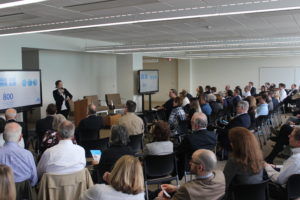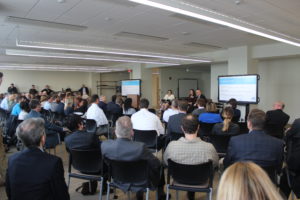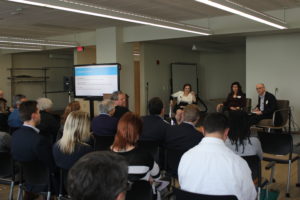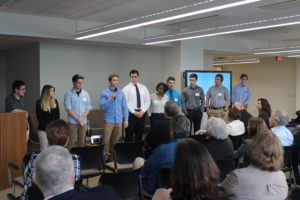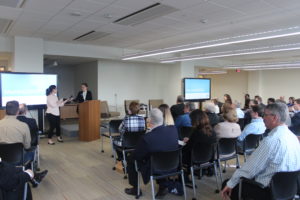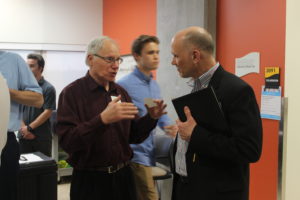Thank you University of Wisconsin – Milwaukee School of Freshwater Sciences for hosting our first Member Meeting of 2017!
By: Isaiah Perez, Membership Manager for The Water Council

February 22nd marked the first member gathering of 2017. It also marked the first time The Water Council (TWC) offered members across the country and world the chance to virtually participate via GoToMeeting (future meetings will also be accessible through the online meeting platform). It was just over two years since the last member meeting was hosted at the School of Freshwater Sciences, in that time many changes have occurred, including the removal of an unsightly coal pile, development of Freshwater Plaza to the west, and early work on a public plaza to the east to connect the community to the water.
LOOKING AHEAD – 2017 Opportunities
Meghan Jensen, VP Marketing and Communications for TWC, was our emcee for this meeting and provided a high-level review of some key metrics from the 2016 Annual Report:
- 800+ pickups in local, national and international media
- 21 international delegations visited the Global Water Center
- 300+ attendees from 20 states and 7 countries at Water Summit 2016
- and many more highlighted included in our 2016 Annual Report
Additionally, Meghan laid out the goals TWC will focus on in 2017, as determined by our Board of Directors, including:
- Focusing on scouting and attracting new businesses to Milwaukee and Wisconsin, including developing a soft-landing package to become the U.S. market entry point for international water businesses
- Continuing to advance our recently launched research and commercialization initiative
- Strengthening our stewardship program for members
- Growing government relations
Meghan also introduced a new section on TWC website, Success Stories that highlights how individuals from various walks of life are leveraging TWC’s platform to help improve world water health. Attendees were encouraged to share their story for potential inclusion in the future.
Lastly, a number of upcoming engagement opportunities were shared, most notably the newly renamed Water Leaders Summit, to reflect the quality and caliber of attendees and programming the tenth annual Summit offers. Water Leaders Summit will take place May 23-24 in Milwaukee with a focus on water security in the realm of organizational, environmental, cyber and diplomatic security.
KEYNOTE CONVERSATION: Circular Economy – Is Water the Natural Starting Point for Circular Economics?
A large portion of the meeting was dedicated to a presentation, conversation and Q&A session with guest speaker Laura Shenkar, Founder and Principal at Artemis Water Strategy (San Francisco, CA). Laura is a leading expert on advanced water technology and its potential for business operations. The focus of the first part of her presentation was to introduce the concept of a circular economy, where inputs are reused and waste eliminated, a practice common in Europe, and only now being introduced in the U.S. She also aimed to discuss how Milwaukee can leverage its position as a water tech cluster to begin implementing a circular economy, and the potential impact it could have.
What is the Circular Economy?
When talking about a circular economy, you talk about a moment in time where you simply run out of “stuff.” Theoretically, you will run out of the raw ingredients that make all the things that humanity enjoys. Multiple factors contribute to this phenomena including a growing population, scarce resources and a need for more energy. By 2030, the world’s population will reach 8.3 billion, requiring 50% more food, 45% more energy and 30% more water. “Eliminating waste,” according to Shenkar, “is one of those overlaps between business and the environment, better systems produce more water and less brine for costly disposal.” Shenkar has watched as more efficient waste management systems have emerged in Europe for many years, citing that they were the first locale to see that 21st century manufacturing would be much different than 20th century practices; mainly that the world would run out of raw materials that have enabled mankind to produce, deliver, use and throw away.
Circular manufacturing describes a restorative, regenerative design for manufacturing that replaces the linear approach that defined industrial efficiency during the 20th century. The circular economy is gaining considerable amount of attention, from a conference in the EU on the subject that recently attracted 700 attendees, to an entire blog from Britain’s Guardian newspaper strictly devoted to it. More and more people from all levels of business are becoming intrigued with the idea of using resources more productively, creatively and profitably.
What is the Role of Water?
The idea of a central economy is new to water in the US, and hasn’t received much attention thus far, but it will become increasingly relevant as water scarcity begins to dictate changes. Already across the North America, especially in the west, more communities are requiring business leaders collaborate with utilities to develop long-term water use plans.
An example provided in California, the state’s highest officials have pushed the responsibility for mandatory conservation down to local communities, pressuring them to lead mandatory conservation through collaborative agreements. A case study on DC Water can be found in the attached slideshow.
What is the potential in Milwaukee – Panel Conversation Takeaways
Laura Shenkar, Founder & Principal, Artemis Water Strategy
Kimberly Kupiecki, Strategic Marketing Director, Dow Water & Process Solutions
H.J. Dewes, Director (HJ), Product & Sales, ABB
H.J. – There is an opportunity for private enterprise to lead by example, when it comes to implementing a circular economy model in Milwaukee, and across the United States. ABB is leading the charge, producing an annual sustainability report, utilizing a number of tools to reduce their energy and water consumption as a leader on the path to a circular economy.
Kimberly – From a Dow Water perspective, growth opportunities continue to emerge in alternative water sources, specifically wastewater. The emergence of the Internet of Things (IoT) will also play a more important role in the adoption of a circular economy model.
Laura – Milwaukee is in a special position because it is not an enormous city, with enormous political grid-lock, it is small enough so that you can really move the necessary pieces around.
H.J. – The collaboration at the Global Water Center, the environment around technology development, is a key differentiator for Milwaukee as it explores developing a circular economy around water.
Laura – The abundance of freshwater in Milwaukee will ultimately be the biggest challenge the city faces in creating a circular economy around water. There is no sense of urgency, as it exists in Singapore or Israel where they have no water, to solve a scarcity problem, or implement models to reduce or reuse water consumption.
H.J. – On that abundance, it has spawned area universities to invest and create programs around freshwater, to ensure future generations of talent will be much more water centric than anyone historically in Milwaukee. That’s a huge differentiator, as it is not happening anywhere else.
There are paradigm shifts that will need to take place across the United States before the circular economy model for water can take place. It will take a series of communities that will lead the way, and become the model for other municipalities, which Milwaukee certainly has the opportunity step up to the plate, based on the assets already in place.
We hope to see you at our next member meeting scheduled for September. View our calendar of events. View the presentation.
